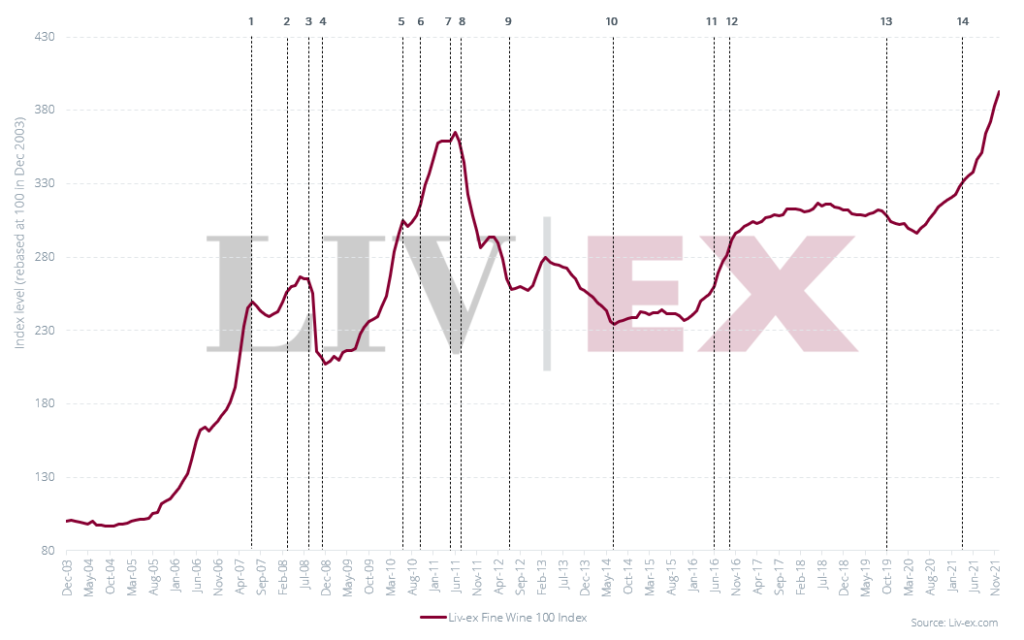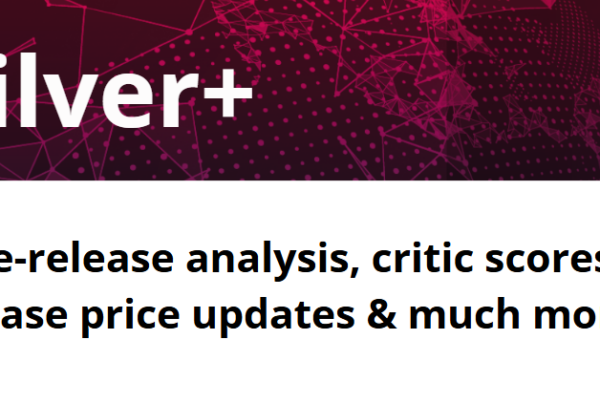‘For centuries Bordeaux has commanded an almost mythical status in the world of wine. Beguiling kings, emperors and dictators alike. While its survival is dependent on the capricious nature of weather, its prosperities has always been tied to shifting fortunes of global economies. As powerful nations rise and fall, so does the fate of this place’ – Red Obsession.
The relationship between macro-economics and wine prices
Fine wine, like all markets, experiences cycles. During World War Two, prices rose by 600% while Germany occupied France. They then collapsed by 50% when the war was over. Similar cycles were witnessed in the 70s, 80s, 90s and more recently from the mid-2000s when China entered the market.
These more recent cycles are reflected in the performance of the Liv-ex Fine Wine 100 index, which represents the price movements of the top 100 most sought-after wines on the fine wine market.
As the chart below shows, significant macro-events can have an impact on wine prices. For example, there was a sharp fall in September 2008 (3) when the Lehman Brothers filed for bankruptcy, signalling the start of the Financial Crisis.
Other major political events have also impacted the fine wine market, such as the weakening of Sterling following the UK’s Brexit referendum which provided a boost to the market (11). The US’ introduction of tariffs on French wine (13) also spurred prices for those that were exempt.
However, the sharpest increase in wine prices was between 2005 and 2011, when China tuned in to the fine wine market.
The Liv-ex 100 Index since inception
Timeline of key events:
- July 2007: Hong Kong cut duty from 80% to 40%.
- March 2008: Hong Kong cut duty to 0%.
- September 2008: Lehman Brothers file for bankruptcy, signalling the start of the financial crisis.
- November 2008: China announces economic stimulus programs: 4 trillion yuan of investments in areas such as infrastructure, transport, industry, tax cuts and finance. Chinese interest in fine wine, a popular gift among officials, steadily increases.
- June 2010: The Bordeaux 2009 vintage is released En Primeur at all-time high prices.
- October 2010: China’s economic stimulus package was a success and purchases of luxury goods in the country were booming.
- May 2011: The Bordeaux 2010 vintage is offered for sale at record prices, testing the strength of the market.
- August 2011: The fine wine market peaks before experiencing a downturn in prices.
- July 2012: China announces a crack-down on gift-giving of luxury goods among government officials.
- July 2014: The market hits its lowest point since before the China-led boom.
- June 2016: Sterling weakens following the UK’s ‘Brexit’ vote. This provides a boost to the market as stock held in the UK is effectively discounted to overseas buyers.
- September 2016: Liv-ex saw its first ever trade for Chinese wine, when a 6×75 case of Ao Yun 2013 traded.
- October 2019: Following disputes over the WTO’s ruling on the Airbus/Boeing dispute, the US introduces 25% tariffs on European goods, including wine. Regions exempt from the tariffs saw the biggest price appreciation in 2020.
- March 2021: China formally introduces tariffs on Australian wine.
The rise of a new wine buying superpower
The Global Financial Crisis did little to slow demand from China (in fact it did quite the opposite). In the months following, China joined several major nations and announced a 4 trillion RMB stimulus package (4). Despite this, the financial markets remained sceptical.
The following March, when equity markets were on their knees, the ‘middling’ 2008 vintage from Bordeaux was released into a void. The annual En Primeur tastings were poorly attended and from those who did, the wines received a lukewarm reception. But not so from the one person that really mattered.
Midway through the campaign, Robert Parker surprised many with a glowing report and the generous prices that were being offered soon vanished. The releases that followed came at the same level or at a premium to the previous vintage. And with it, the brief period of market weakness was over.
The following year, when tasting the 2009 vintage at En Primeur, Robert Parker famously declared that it ‘may turn out to be the finest vintage I have tasted in 32 years of covering Bordeaux’. The wines were subsequently released at record prices (5) reflecting not just their quality but broad-based global demand, led in no small part by the vast sums of newly created wealth in mainland China.
The market was running super hot when yet another highly praised vintage (2010) was offered at a 13% premium to the previous year (7). American buyers still recovering from the financial crisis and with cellars recently topped up with 2009, withdrew from the campaign. Increasingly the ‘old hands’ were concerned that irrational exuberance had taken a grip and Bordeaux was pricing itself out of the market.
But as one super-power turned away, another took up the slack. The effect of China’s stimulus package was still being felt. A new generation of buyer had been born and (perhaps dangerously) had only known a bull market. Purchases of luxury goods were booming and Bordeaux was capitalising on it.
This perfect storm of (a perceived) insatiable buying interest from China and yet another ‘vintage of the century’ coming to the market led to record high prices in May 2011. It would prove to be the peak. The 2010 vintage, released at higher prices than 2009 despite lower scores, went into fewer cellars in greater quantities. Speculation was rife adding to a dangerous cocktail.
Not only was 2010 stretching balance sheets, but China’s government was soon to introduce a gift-giving ban that would prove to be the mortal blow to the speculative clamour surrounding Bordeaux (9). Overnight demand collapsed and merchants were left with cancelled orders and excess stock that would take years to deplete. The Bordeaux market fell into a steep decline that endured for the next five years.
China’s influence on the market today
Since 2010, the fine wine market has significantly expanded and China no longer has quite so much influence on prices. With the border between Hong Kong and China closed to tourism, Hong Kong itself has seen its influence diminish. But this is not to say that greater China is not important to the global market.
Buying spikes are witnessed ahead of Chinese New Year, with many purchasing wines from previous vintages of the same zodiac. Commemorative bottles continue to be released specifically for the Chinese market. Secondary market activity for Australian wine shrunk as a result of recently introduced Chinese tariffs (14).
The allure of China, while not what it once was, has not gone away. Global powerhouses like Domaines Barons Rothschild and LVMH continue to invest in their own Chinese vineyards, and the fruits of this labour are now being recognised. LVMH’s Ao Yun 2013, for example, has seen increased demand on the secondary market in recent years.
China’s emergence as a major player in the fine wine market has led to significant shifts, from chateaux ownership, to distribution and to branding. Although no longer shaping the market (and its prices) as it once did, as inevitable as all cycles are, China will be back. And the wine world will be ready.
Liv-ex analysis is drawn from the world’s most comprehensive database of fine wine prices. The data reflects the real time activity of Liv-ex’s 560+ merchant members from across the globe. Together they represent the largest pool of liquidity in the world – currently £100m of bids and offers across 16,000 wines. Independent data, direct from the market.
Not a member of Liv-ex? Request a demo to see the exchange and a member of our team will be in touch with you shortly.




